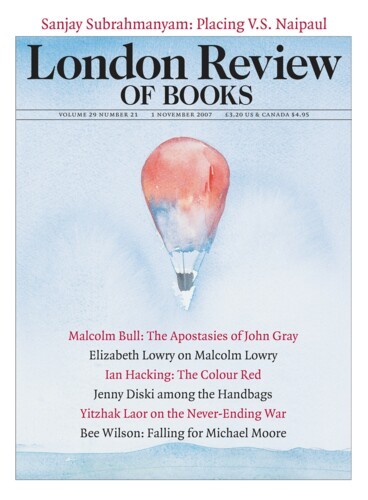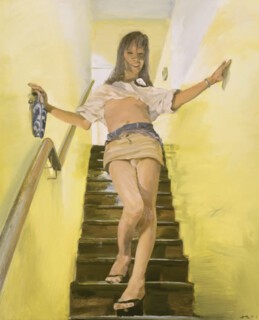The Painting of Modern Life, the first show at the Hayward Gallery curated by its American director, Ralph Rugoff, is an ambitious attempt to see how this artistic project stands nearly 150 years after Charles Baudelaire proposed it in his essay ‘The Painter of Modern Life’ (1863). There the poet called for a shift in subject matter – already begun in the practice of Manet and others – away from the grand themes of myth and history, and towards the everyday activities of urban life, especially of middle-class leisure. Such a shift in content implied a shift in form, even in medium; for example, to capture the mobility of bourgeois types on the town, the sketch might be more useful than other means (the exemplar in the essay is not the great Manet but Constantin Guys, who was then known for his quick studies). What better vehicle to convey ‘the ephemeral, the fugitive, the contingent’ – key qualities of the metropolitan kaleidoscope, according to Baudelaire – than the photograph? Yet the poet remained suspicious of the new medium, in part because he did not see its potential for imaginative invention, in part because he did not deem it suited to the ‘other half’ of his mandate for art, which was to extract ‘the eternal and the immutable’ from this protean modernity. The other half was still the province of painting, and so painting – perhaps pressured by photographic attributes – remained the essential medium.
The Hayward show picks up the representation of modern life a century later. In the interim, Rugoff suggests in the catalogue, the tense relationship between painting and photography slackened, as painting withdrew into abstraction (a comment on modernity in its own right), and photography became the favoured means of modern imaging (there are many exceptions, of course, but the curator should be allowed his premise). However, as the 1960s began, Rugoff continues, artists associated with Pop and photorealism – Richard Hamilton, Andy Warhol, Gerhard Richter, Richard Artschwager, Vija Celmins and Malcolm Morley – turned again to photography, not only as a source of images but as a way to convey the look of consumer society, already processed as so much of it was through photographic media: that is, through the ads, news photos, amateur snapshots and postcards that the painters had begun to adapt.
The exhibition begins here, and the early work looks superb still, fresh to the eye, however familiar the artists are now, and incisive about its times. In the first galleries Rugoff offers a nice range of photographic effects translated into painting in this initial moment: Hamilton capturing the tabloid glare of celebrity visibility in a lurid image of Mick Jagger handcuffed to the art dealer Robert Fraser after a drugs bust; Warhol eliciting shock cut with indifference with a newswire photo of a car crash silk-screened 11 times across a rust-orange canvas; Richter producing an empathic response in his blurred representation of a pretty woman distorted by grief (we learn it is Jackie Kennedy after the assassination); and so on – so many visions of a world more and more mediated by images, which painting, because of its remove and its delay, is able to explore in ways that photography cannot.
Yet the great interest of the show is the uncertainty – the epistemological ambiguity, the historical instability – visited on both photography and painting over the last four decades. The two media partake of different sign systems: photography is conventionally seen as indexical, a photochemical impression of the world, and (representational) painting as iconic, with a resemblance to the world that is less direct, more mediated by material, touch and tradition. A painting is also worked up over time, and usually taken in over time too; Rugoff writes well about the ‘slowness’ of painting, which in this instance allows us to review and to reflect on its photographic sources. Yet even in the 1960s these different attributes are not easily assigned to one medium or the other.
Take the vaunted reality effect of photography, affirmed by theorists from André Bazin to Roland Barthes. Some of the artists in the show are not so sure. Richter remarks that photography is ‘a crutch to help me get to reality’, yet that he can approximate this goal only through painting; this leaves him with the paradoxical formulation, ‘I am practising photography by other means.’ For Celmins, whose meticulous translations of a Time magazine cover, military craft and a Los Angeles freeway are on display, it is also painting, and not photography, that puts the image ‘back into the real world – in real time … the here and now’. Moreover, as the show proceeds, the source images become less photochemical, more electronic, less analogue, more digital (they often derive from television, video and the internet), and so what counts as the photographic gets stretched – stretched, in fact, towards painterly manipulations. Hamilton explored this complication early on; as early as 1969 he noted the proliferation of ‘lens-formulated images whatever the chemistry or electronics involved.’
Consider, too, the question of spectatorial distance: is this a photographic quality or a painterly one? For Rugoff, it seems, it is painting that builds such detachment into the work, yet for others this distance is associated with photography: Richter speaks of his photographic blur as a ‘protection’, and Warhol of his photographic repetition as an anaesthesia (‘meaning goes away’). Or consider, conversely, our proximity to the image, as with the photorealist canvases of Morley, who describes his painting as a ‘hallucination’, or of the Swiss artist Franz Gertsch (a welcome rediscovery), whose huge scenes of hippy life loom towards us with garish details: neither strictly photographic nor strictly painterly, this visual intensity is effected through a combination of properties of both media. Indeed, some of the best works in the show mix effects of distance and proximity, the detached and the insistent, through a precise complication of painting and photography. Rugoff describes this mixed quality as ‘uncanny’ or ‘absurd’, but little seems repressed here, and nothing nonsensical; his impression of a ‘denatured’ world is more exact. Abstract painters like Kandinsky, Foucault once argued, did away with resemblance, but still affirmed the real; they simply located it elsewhere, in a transcendental beyond. Surrealist painters like Magritte performed a stranger trick: they held on to resemblance, but allowed the real to slip away; similitude remained while reference vanished. For some of the artists here this appearance without substance is the odd nature of the postwar world, and they bring us back compelling probes of it – of where the real looks lost and where it erupts again.
A divide opens in the show as one moves through it. Is its principal concern the photo-painting relation or the representation of modern life? Some works lean to one side, others to the other, but only the best hold the two subjects together, and they are able to do so precisely because the photographic and the painterly charge each other, and burn the image into its moment (and vice versa). Often in the more recent paintings this tension slackens, and purchase on the world slips as a result (the loose categories – looser than in Baudelaire – don’t help much here: ‘History & Politics’, ‘Leisure & Everyday Life’ etc). Sometimes, too, even as the category of the photographic expands, the use of the photographic contracts; it becomes more traditional, mostly a matter of sources again, with the result that little pressure is put on painting, which in turn can scarcely push back on photography. How different from Warhol, who places nasty news photos in the space of exalted abstraction, or Hamilton, who tests the great tradition of the tableau with the slick devices of advertisements. In short, many of the younger artists allow painting to trump photography too easily. Painting gets the victory, but it is Pyrrhic, and for all its advocacy the show might make some viewers feel less sanguine, not more, about the current state of the art.
The reason this issue is more than academic is that the representation of social existence is at stake here. If, for Baudelaire and company, modernity was a great fiction to celebrate, it was also a terrific myth to interrogate – and how much more so is it for us today. As art historians such as T.J. Clark and Thomas Crow have helped us to see, the great painters of modern life – from Manet to Hamilton – are also its great dialecticians; they are able to celebrate and interrogate it by turns. Hamilton uses the Duchampian phrase ‘ironism of affirmation’ to convey his edgy position on this score. Too many of the artists in this show are neither affirmative nor critical enough – of painting, photography, electronic images or modern life. In 1865 Baudelaire wrote to Manet that he was the first in the ‘decrepitude’ of his art; it was meant as a compliment.
Send Letters To:
The Editor
London Review of Books,
28 Little Russell Street
London, WC1A 2HN
letters@lrb.co.uk
Please include name, address, and a telephone number.


